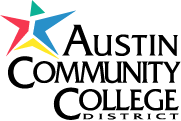ACC graduate Rachel Price is a technician on a research team working in Antarctica. The Austin-American Statesman profiled Rachel on December 7. Check out the story here. Read on for more from Rachel.
It’s 33˚ Fahrenheit right now in Taylor Valley, Antarctica. But that’s pool party weather compared with some of what my research team has been through over the past eight weeks.
My name is Rachel Price, and I am an ACC student working on a research project funded by NASA at Lake Bonney in Antarctica. I am employed by Del Valle-based Stone Aerospace – a job I got thanks to one of my classmates during my first semester in the ACC Electronics Program. It was supposed to be temporary, but two years later I’m still on board, and in Antarctica no less!
I am here as part of the ENDURANCE project. That stands for Environmentally Non-Disturbing Under-ice Robotic ANtarctiC Explorer. Here’s what that means: We are using a 3,000-pound underwater robotic vehicle to take water chemistry data, make a 3-D map of ice-covered Lake Bonney, and get images of the portion of Taylor Glacier that meets Lake Bonney under the permanent ice cap of the lake.
At first I was mainly doing general repair and maintenance of the “bot,” as we call it, but I eventually began helping on electrical tasks: testing and building cables, modifying boards to given specifications, and occasionally proofreading computer code and troubleshooting systems. I had some experience with building and testing cables before, and I learned the electronics and coding at ACC.
Our work may have another application in the future. This is where the NASA funding comes into play. ENDURANCE is a prototype for a much smaller vehicle that NASA wants to send to Jupiter’s moon Europa, which most scientists agree has a liquid water ocean beneath its miles-thick surface of ice. This ocean is believed to be one of the most likely places in the solar system to find extraterrestrial life.
Living in Antarctica has been a pretty intense experience. I had to go through a field survival course when I arrived in mid-October. We sleep in regular camping tents while we’re in the field; one of my first nights, it was 28 degrees below 0. To stay warm, I would fill Nalgene bottles with hot water and stick them in my sleeping bag.
When we have a little free time, most of us sleep a lot, then try to get in a small hike. We also update our blogs and email or call our families. Storms can knock out our lines of communication, though, and at one point, 45 mph winds brought down Internet, phone, and VHF radio.
We’re wrapping up our work and will soon leave for New Zealand, then make our way home. In this economy, I’m lucky to still be working anywhere, and I’m even luckier to be able to be doing this. Working as a technician for Stone Aerospace, I have done everything from running grinders across rust-ridden gantry cranes to proofreading computer code, which means hardly a boring moment at work. And considering my long-time interest in astronomy and space exploration, one would think that I looked high and low for this opportunity, but in fact it found me at a time when I probably would have taken any job I could get. You can hardly get better fortune than that.
I graduated in May with an Associate of Applied Science in Robotics, Automation, and Controls Technology. I am returning to ACC in the spring, as I have decided to start working toward a four-year degree in Computer Science, at either Texas State or UT, and will get a few more basics done at ACC. My education at ACC led me to this amazing research project, and it has enabled me to work with technology I never thought I would see firsthand. My experiences have inspired me to always keep learning as much as I can.
Back to Top





By S. ATTIX December 18, 2009 - 11:18 am
Rachel is a model of exactly what we are trying to encourage in the new “Women In Green Jobs” Campaign – here at ACC! Only 10% of the students taking “Green Tech” related coursework at ACC – is currently female! We need to DOUBLE that amount of enrollments – this next year! [How can we reach Rachel with comments and an invitation to be “Profiled” on our web site: TBA for a January launch date.